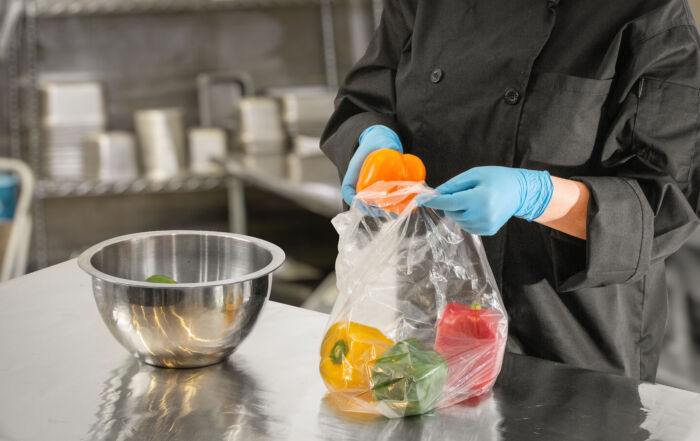The Cold Chain in the Hot Summer Months
 Keeping foods at proper cold holding temperatures (between 28°F and 41°F maximum or 0°F for frozen food) from the food manufacturers to your customers has to be one of our strongest links to safe food. Sometimes that is referred to in the food industry as “maintaining the COLD CHAIN”. Any slip ups in the cold chain, and we have a weak link. If you accept the food, you have greatly increased your foodborne illness risk and compromised your food quality.
Keeping foods at proper cold holding temperatures (between 28°F and 41°F maximum or 0°F for frozen food) from the food manufacturers to your customers has to be one of our strongest links to safe food. Sometimes that is referred to in the food industry as “maintaining the COLD CHAIN”. Any slip ups in the cold chain, and we have a weak link. If you accept the food, you have greatly increased your foodborne illness risk and compromised your food quality.
The Cold Chain vs. Hot Summer —One of our problems in the hot summer months is receiving our cold foods cold at the 41°F maximum or below or frozen foods solidly frozen at preferably 0°F (maximum of 10°F). We experience delivery and transportation delays, truck delivery doors open in 80°F + weather conditions, and last delivery when the refrigeration on the truck cannot recover from the open doors. Perishable foods (refrigerated or frozen) are easily affected by high temperature fluctuation.
The Worst Potential Nightmare—Receiving Hot-shot Deliveries —Sometimes we experience of what is called “hot shot” perishable deliveries when you are short of product. Either you pick up at the will-call distributor doors without a cooler unit in your vehicle or the distributor delivers your perishable food in un-refrigerated trucks just to get it to you faster. There has been suspect foodborne illness cases related just to that type of scenario, where a manager made a choice to accept 60°F+ perishable foods that they were short (a hot shot delivery) prior to a big event.
Our best advice here is to use a stem thermometer, take the temperature upon receiving the perishable products, and reject it if there’s any question. If you pick the food up, take a thermometer with you and make certain you have adequate coolers with ice packs. Remember the food safety words to live by – when in doubt, throw it out.
The Flow of the Food—In restaurants we refer to the stages that food travels through on its precarious route to our customers, as the flow of the food. Those cold stages requiring refrigeration or control of the cold food temperature typically are:
1. Receiving cold or frozen
2. Cold storage and thawing of potentially hazardous and perishable food
3. Maintaining the cold temperature during preparation
4. Cold holding after prep
5. Rapid cooling if a leftover cooked food or pre-cooked ingredient (within 4-6 hours maximum)
6. Cold service to the customer
The Stem Thermometer or Thermocouple is the critical tool for checking our food temperatures, particularly upon receiving foods from our suppliers. The thermometer must be used throughout the workday and as for your temperature readings, the colder, the better! The colder your refrigeration equipment can keep chilled foods without freezing them, the longer the shelf life of the food. Storing cold food at an internal temperature of 35°F instead of 41°F might double the shelf life of some foods.
Cold Capacity–Refrigerators, refrigerated prep cases, deli cases, and walkin coolers all differ in their capacity to keep foods cool and recover after being open. In all instances, the air inside the refrigerated compartment must be a few degrees colder than 41°F to assure that cold food internal temperatures are held at 41°F or below. For example, if you want your food to cold hold at 35°F, you refrigeration unit has to run an air temperature of 31°F to 32 °F. Older refrigeration equipment may not be designed to hold at that low of a temperature. Areas near the door are always warmer than anywhere else in the cooler.
Take Cold Storage Temperatures & Save $ — Dairy, fresh seafood, poultry, meat and deli type meat suppliers recommend 28-35°F internal temperature for optimum freshness and shelf life. The Produce Marketing Association recommends 32-36°F for most vegetables (other than whole tomatoes that are ripening). Use that thermometer several times a day and record temperatures. Teach your crew what it really means keep the strength in the “COLD CHAIN”.
***
About the Author: Lacie Thrall

This information is provided as a general guideline and is not intended to be, nor does it, constitute legal or regulatory advice. Additional Federal regulations may apply to your particular circumstances. State, regional and local laws, ordinances and regulations may also apply.
READ MORE POSTS
Preventing Norovirus in your Foodservice Operation
Norovirus is one of the leading causes of vomiting and diarrhea in the United States, [...]
Safe Handling of Leftovers in Foodservice Operations
In any foodservice operation, leftovers are inevitable. After managing a family-style restaurant, where all-you-can eat [...]
Turn your Health Inspector into your Food Safety Ally
For many foodservice operators, keeping up with evolving regulations can feel like chasing a moving [...]
Time and Temperature: Why 41°F to 135°F?
In one of my last blogs, I mentioned the temperature danger zone, or TDZ, as [...]










